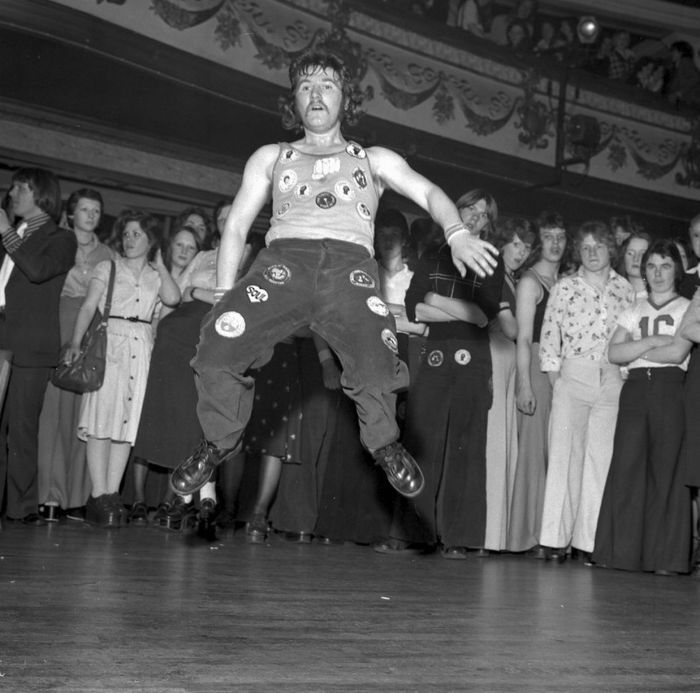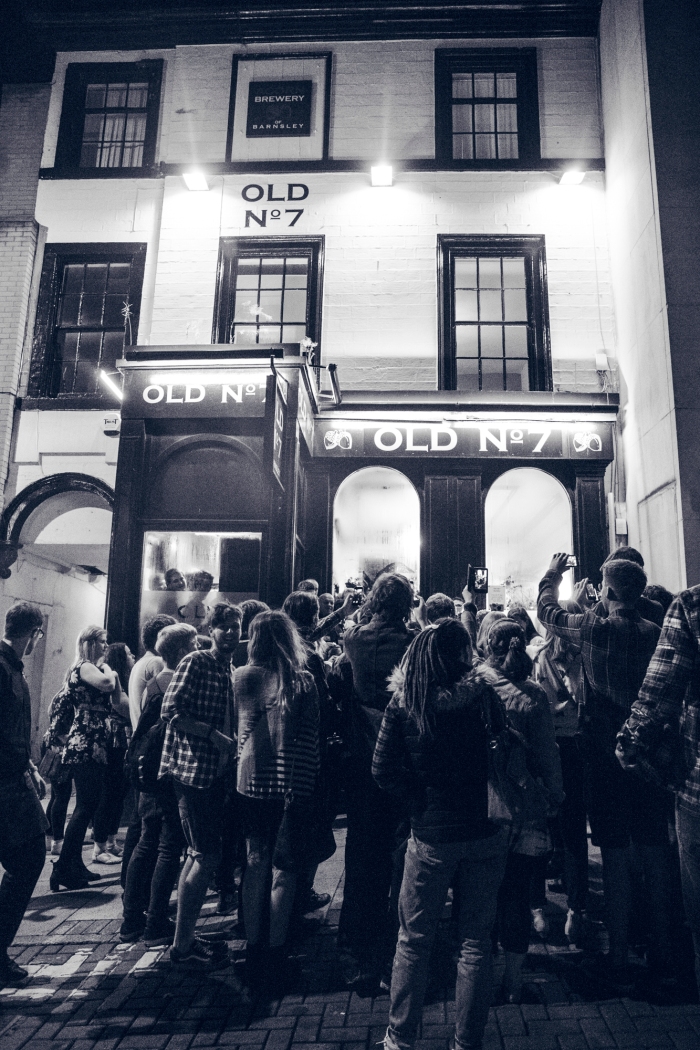
In this posting, I want to explore how and where Barnsley people were entertained during the late 1970s, especially at the weekends and especially in nightclubs.
This post is an expanded version of an article published in Memories of Barnsley magazine for autumn 2017.
Pubs & bars
One obvious answer to this, of course, would be drinking in the pub. This was a time honoured and traditional pastime, seemingly for all those over the age of about 13. Numerous pubs thrived, which today have been converted to flats or convenience stores- the Wilthorpe and the Redbrook are examples close to my childhood home. I joined the culture of underage drinking at fourteen or fifteen, thanks to the relaxed policies of the bar in the Centenary Rooms, and took the ready availability of alcohol for granted. It was at this venue that I learned to drink, I learned many painful lessons of love and romance, I saw Saxon/ Son of a Bitch play and I first performed in a band on stage myself, as I have described in posts and elsewhere.
The authorities had a different view, however. The chair of the licencing justices complained in January 1979 at the rise in offences over the preceding year: 92 under-seventeens had been convicted of drinking offences, including girls as young as fourteen. “There appears no doubt that drunkenness- together with the accompanying deplorable behaviour which must be tolerated … is on the increase.” I was an offender just as much as those unfortunates who were caught- and many of those who have shared their reminiscences of venues were similarly present illegally.
Turning back to legitimate forms of fun (!), what is impressive is the sheer number of clubs, pubs and discos that were available, just within the boundaries of South Yorkshire and in smaller towns and locations where you would not expect them. I presume that this must be explained by the increased mobility of young people: they could afford cars and they could afford the fuel to travel to venues. At exactly the same time, though, they were not inclined to go very far. Why go to Leeds or Sheffield when you only had to go to Mexborough in your search for a good time?
Across the area working men’s clubs offered bars, discos, live bands, comedy and bingo. Weekly events were advertised consistently at the clubs in Greenside, Shaftoe, Swaithe, Kexborough, Staincross, Jump, Mapplewell, Ward Green, Dodworth and Worsborough. Large employers provided similar attractions, for example the NUM and the Yorkshire Traction social club, which offered strippers with your Sunday roast lunch. The aforementioned Redbook staged dance nights on Tuesdays in the mid-70s, with Maisie on organ and Johnny on drums.
Cinemas
Another traditional place of entertainment was, of course, cinemas. You did not only see films at the Barnsley Odeon, but also at a council run screen in Penistone and at the Futurist in Elsecar. The latter, at the start of the period, was a general cinema showing the usual spread of family and over-eighteen films. Fairly quickly, though- perhaps because of competition and waning attendances- it became rather more ‘specialist’ in its programming. Sample saucy offerings include When girls go to bed, Carnal knowledge, Do you believe in Swedish sin? and Prickly problems (not, I assume, about cacti). Bizarrely though, amidst the X-rated fare, the odd Disney cartoon still appeared at matinee.

Nightclubs
Young adults after something other than The ups and downs of a girl on holiday still had plenty of swinging venues to choose from. Within Barnsley town itself there was the YMCA, offering a ‘Top of the Pops’ disco on Wednesdays for 20p; Changes at 2, Sheffield Road, was a pub mainly putting on local heavy metal bands, but with Lynn the go-go dancer at weekends; the Stables Club in Peel Street, is remembered with affection, but is generally described as ‘grotty,’ and Jim’s Inn on Doncaster Road, was a private members’ club that offered cabaret and dancing. The Inn was named after a popular TV series of the late 1950s and catered for an older and more affluent clientele than some night spots.
The leading venue in town was probably Baba’s disco in Queen’s Road; it claimed it was Barnsley’s “biggest and best disco scene.” It was popular with hen nights, works parties and footballers, but it also staged live acts, including Geno Washington and Bilbo Baggins in early 1976 and, in January 1974 Heatwave, who were unfortunately promoted to the locals as a “coloured American song dance group.” The venue was acquired by Granada Theatres early in 1975.It was closed for refurbishment later in the year, reopening in late November with a new sound system and light effects. The new owners had spent £10,000 (£59,000 today) on 700-watt amplifiers and sound to light equipment copied from Paris, Oslo and Geneva. There was also new décor and furnishings and the ability to show films. The emphasis remained on dancing, although rock music was also promised.
Club Baba closed again for refurbishment in mid-1976 but had reopened by early 1978 as Rebecca’s, with “new super sound, new décor and new sophisticated lighting.” Admission to all of this was just 75p before 10pm (about £5.75 today) and they offered regular drinks promotions (spirits 20p all night); themed nights such as St Trinians, Treasure Island and Pink Panther, and annual ‘Miss Rebecca’s’ competitions. The disco claimed, in slightly sinister terms, that it was “where one could meet one’s match.” I think we know what they meant.
Still within the wider Barnsley area, there was a remarkable choice of venues. The Pinfold Hotel, Cudworth, put on Friday night discos; the Londoner, Lamb Lane, Monk Bretton, was a former casino that claimed it was “the most exciting disco pub in town” with dancing on Friday, Saturday and Sunday nights; in Royston was Tassel’s Club, a dance school that also presented live bands such as Middle of the Road, of ‘Chirpy, chirpy, cheep, cheep’ fame. In Kings Street, Hoyland, stood the Birdcage, where “everybody meets.” It offered the area’s “number one nite scene” from 9pm to 2am- and for only 60p on the door. A tie was not necessary to get in, but style definitely was, the adverts advised: they pictured a young woman in shorts, boots and bra-less in a short, unfastened waistcoat. The club featured palm trees inside and is most memorable for the fact that, if a beer barrel ran out, the cellar was only accessible through a trap door in the middle of the dance floor, which necessitated clearing the dancers for a time. Bands played the Birdcage too, including circuit regulars Ponder’s End and Bitter Suite. Copied by Rebecca’s, the club organised an annual Miss Hoyland competition. For a while, at least, the Cage extended to the adjoining premises, opening as Cupid’s, “Hoyland’s new superscene”- just in case the Birdcage had failed in its promise to deliver “the best times of your nite life.”
If this wasn’t enough, South Yorkshire’s pleasure seekers had plenty of attractions only a short journey away. In Wakefield, the Theatre Club staged live acts such as the Nolan Sisters, the Three Degrees, The Jacksons, Osibisa, Alvin Stardust, Gene Pitney and Charles Aznavour. The Golden Girl Nightclub in the same town also offered bands, such as Paper Lace in January 1979. Heading south, the Fiesta in Sheffield booked names like the Drifters and the New Seekers, and there was dancing at the Top Rank Suite and Crazy Daizy at the Mecca. Still feeling jaded? Then you could try Tiffany’s in Rotherham, Wordsworth’s Ballroom in Pontefract- which featured bands and discos- or Jesters in Mexborough, where the Drifters appeared in November 1976.
For sheer bizarreness, Kiko’s in Pontefract has to be mentioned. It advertised itself as the town’s number one exotic Polynesian nightclub. “A splendid time is guaranteed for all” in “breath-taking surroundings” the adverts promised. The venue was famed for its plastic palm trees and was immortalised by John Godber in his play Bouncers.

Northern soul venues
Parallel with the regular clubs, there was the sub-culture of Northern Soul. The Londoner in Monk Bretton offered Northern Soul nights on Monday, which were a big draw for local youth, including a high proportion of under-eighteens. The Portcullis Club put on an all-dayer for over-eighteens in May 1975. The event ran from 2pm until 11pm; the entry fee was 75p, with a bar and food provided.
Wordsworth’s had Northern Soul nights; so too did Bailey’s in Doncaster. The latter’s adverts featured drawings of typical 1970s ‘dolly birds’ dancing to the latest sounds, but the club established a firm reputation as one of the venues on the all-dayer and all-nighter Northern Soul circuit, competing with Cleethorpes, Blackpool and Wigan. It drew audiences from as far afield as the East Midlands and East Yorkshire and offered twenty-four hour marathons on Sundays. Finally, there was Raquel’s in Wakefield, which had two floors of music: Bowie and Roxy Music upstairs and soul classics such as R. Dean Taylor and Gloria Jones downstairs. It drew coach loads of soul fans from a wide area and the 50p entry even included a meal. Once again, the club had a large underage clientele: one weekly regular recalled doing his homework under the tables in the bar during the midweek soul sessions. Raquel’s even offered hard-core devotees an all-nighter on December 25th 1976- a radical new approach to ‘keeping the faith.’
Northern soul was often blighted by its association with dance floor drugs. Witness of this was Barnsley magistrates’ refusal in April 1975 to licence an all-nighter at the Civic Hall. Although the applicant had run events in Cleethorpes and Doncaster without incident, the town police objected because of the likelihood of drug use and ‘trouble.’ Of course, this is of a piece with the overreaction to Barnsley’s only ever punk gig– see my two posts on this purported riot- and the rather more legitimate concern about underage drinking.
Too much fun?
If none of this sufficed, though, there was still Antoinette’s Luxury Nightspot at Brierley Gap, Hemsworth. There was dining and dancing on Fridays and Saturdays and sometimes male strip tease compered by a drag act- “See it all for 40p.” This rather remote venue had formerly traded as ‘Eight miles out,’ which described itself as “a bistro, a disco, a country club- and very, very different from anywhere else you’ve ever been.” It offered a northern soul night on Thursdays: “Keep the faith! Come early and often!” was the slightly plaintive slogan. The venue seemed desperate to attract clientele: February 1975 also saw a ‘knicker party’ with ‘knicker bar’(?) and March a ‘stag show’- “girls, girls, girls- and comedian.”
The sheer choice, cheapness and quantity of night life in this period are impressive and even make you feel rather envious of days gone by. Sadly, many of these venues have disappeared now: for instance, the Birdcage burned down in the 1980s and was replaced by flats; the Londoner also burned down whilst the Futurist closed in 1985 and became an auction house.
For fuller details of my fiction and non-fiction writing on music, please see my website.